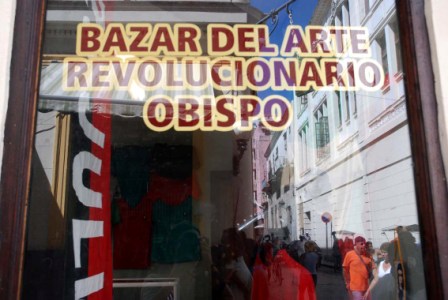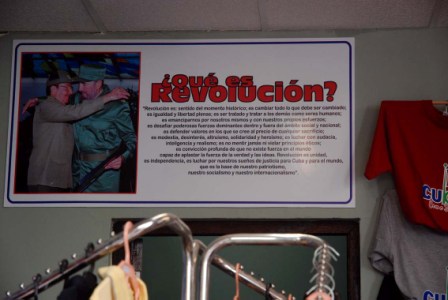A Revolutionary Art Bazaar?
By Irina Echarry

Walking down Obispo Street in Old Havana, I stopped exactly in front of a new establishment. According to the sign above, it was the “Revolutionary Art Bazaar.”
So I entered to see what this was. I was expecting to find the best of the Cuban artistic vanguard of the 21st century: plutonium sculptures or videos that showed presidents from across South America urinating in the privacy of their homes. Or perhaps there would be some portrait painted with petroleum (men and women digging up the soil with their hands) as the symbol of future human destruction; robots that caress or hit the head of a boy who sleeps; pictures that – when looking at them – turn you into the image that is captured by the photographer as live virtual reality… I didn’t know.
I thought of works that would mark some difference among the art that is currently produced in the country. But what I found was something else.

I immediately understood that the name of the establishment was a sad joke – in all senses of the expression.
A bazaar is a store in which a variety of goods with multiple uses are sold. Here, the only things being sold were objects with the faces of Che or Fidel on them. Nonetheless, I imagine that this could be considered a bazaar, since they were selling tee-shirts, key rings, DVDs, books… although nothing like the bazaars we see in Asia in the movies.
What was really an insult, though, was the use of the word “art.” Art seeks aesthetic enjoyment; it is supposed that our senses receive some stimulus from the object that we have before us. The observer either reacts with pleasure or rejection, but that can only happen before a truly artistic effort.
If the goods on sale had at least been handmade, that is to say, had they been products of the labor, patience, dedication and imagination of some artisan, they would have had some value. But what I found was something else. So I didn’t understand why they used a word that embraced such a lie. Art is, above all, authentic.

On the wall was a poster with the images of Fidel and Raul Castro. In the middle of the two men was written the concept of revolution from one of the commander-in-chief’s speeches. As profound as that may be, I’m not quite sure that it qualifies as art either.
For those people who are not interested in Che as a historical figure or as a human being, the visit to the bazaar will inspire nothing. What’s much worse though is its impact on anyone who does admire Che. What will they feel when they see people practically pimping his image? Would Che himself want his image sold this way, as if he were a Hollywood movie star? That we’ll never know.
Revolutionary? This means a rabble-rouser, a rebel, someone who overthrows what is established, a troublemaker who affects deep transformations. Our rebels saw their time pass by long ago. Like Gilgamesh, the Sumerian legend, they too failed to find the source of eternal youth. Unfortunately for everyone (them and us), they were rebels 50 years ago. Now they are old men, stuck in the routine that they created.
This is the same routine that gives such absurd names to establishments that simply collect money (much needed by the country) by selling clothes with the images of heroes, or that hawk books and DVDs that document some historical deed. Still, I’m not sure how much comfort there is in knowing that the face of some famous Cuban guerilla fighter, tucked into someone’s back pocket, is keeping guard over our keys.

I enjoyed your observations.